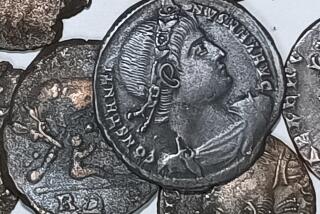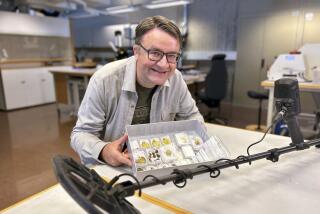Treasure of Ancient Gold Discovered in Bulgaria
- Share via
More than 15,000 small pieces of finely crafted gold have been discovered in a group of 4,500-year-old graves from central Bulgaria, a trove of beads, earrings and other small artifacts that were buried with a chieftain or king sometime before the 23rd century BC.
The find in the small village of Dabene, about 75 miles east of the Bulgarian capital of Sofia, dates from about the same period as the ancient city of Troy. Some researchers have suggested that gold workers from the area may have produced much of the treasure found at the site of Troy, in what is now northwestern Turkey, and other cultural centers of the period, such as Mycenae in Greece.
The find indicates that the village “had a very impressive social elite that could be compared with that of Troy,” said archeologist Lolita Nikolova, who has worked in the region but was not involved in the find.
These are the first cemeteries in the area that have been found from the Bronze Age period, and they indicate that “the village was in close contact with cultures to both the east and west,” she said. “These discoveries will rewrite all the prehistory of the Balkans.”
The gold artifacts were placed on display last week at the National History Museum in Sofia, where curators polished the pieces and restrung the golden beads to make necklaces that would not look out of place if worn on Sunset Boulevard.
The site was excavated by archeologist Martin Hristov of the museum, who has been working at other sites in the region.
Last year, two young archeologists on his project were purchasing cigarettes at a shop in Dabene when they observed a gold necklace on a farm woman.
When queried, she said her husband had found the necklace while plowing his fields. He, in turn, showed them the primitive cemetery, about 200 yards from where Nikolova had been working.
The site contains four tumuli, or burial mounds, each about 6 yards in diameter and projecting an inch or so above the surface.
When the members of the team excavated the tombs, they found that the bodies had been cremated, the first time that form of interment had been seen in the area. There were only “very little pieces of bone,” Hristov said, “and we can’t tell for sure how many people” were buried.
They also found bronze knives and pottery, which had been made in the area and were characteristic of the early Bronze Age, he said.
One grave did not contain any gold, and a second had 21 pieces, he said. But the third contained more than 15,000 individual pieces, including small beads, rings and fine spirals that may have been earrings.
The find is not the first discovery of ancient gold in the region. Earlier studies have shown that the area was home to some of the world’s first gold workers, who mined the Carpathian and Sredna Gora mountains about 6,700 years ago and panned in gold-rich rivers.
At Varna on the Black Sea coast, researchers from the museum recently excavated more than 3,000 artifacts from the 5th millennium BC totaling more than 13 pounds in weight. A variety of other, more recent artifacts have also been discovered in the last year, including a 4th century BC gold wreath, a gold cup and a plate-sized solid gold mask.
The Dabene discoveries, Hristov said, provide a crucial link between the older finds and the more recent ones, indicating that gold production may have been a continuous process in the region over many millenniums.
The identity of the gold workers remains something of a mystery. A few hundred years after the Dabene gold was buried, the region was occupied by the Thracians, a powerful culture ruled by a priest-king. The Thracians did not have a written language, and most of what is known about them comes second-hand from the ancient Greeks, who considered them barbarians.
For lack of a better term, Hristov calls the gold workers of Dabene proto-Thracians. He hopes that continuing excavations will reveal much more about them.
More to Read
Sign up for Essential California
The most important California stories and recommendations in your inbox every morning.
You may occasionally receive promotional content from the Los Angeles Times.










